|
Many guys my age (65)
remember seeing advertisements back in the 1960s, 70s, and 80s for the Bensen
Gyrocopter in the pages of magazines like Mechanix Illustrated, Popular
Mechanics, Science and Mechanics, etc. Bensen stopped kit production in 1988.
This 1954 issue of Popular Science magazine featured a story on Igor Bensen's
early towed version of his gyrocopter (model B−6), which he referred to as a gyro−glider.
According to later published information, the round tubing used here was
replaced with square tubing due to difficulties in building experienced by
owners. Prior to opening Bensen Aircraft Company, Dr. Bensen designed gyroplanes
and related aircraft for General electric and
Kaman. I never had
any hopes of being able to build a gyrocopter, but did hold out some hope for
maybe building one of the lawn mower engine powered hovercraft that also showed
up all the time. Alas, neither was ever done.
He Rides a Kite
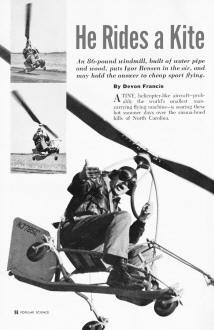
An 86-pound windmill, built of water pipe and wood, puts Igor
Bensen in the air, and may hold the answer to cheap sport flying.
By Devon Francis
A tiny, helicopter-like aircraft - probably the world's smallest man-carrying
flying machine - is soaring these hot summer days over the sienna-hued hills of
North Carolina.
The machine weighs 86 pounds. Its pilot weighs 210. It flies handily at 25 miles
an hour. It will land at seven miles an hour. The thing was built by an engineer-scientist
named Igor Bensen. He says that practically anyone could build one. The estimated
cost: $100.
Bensen's aircraft is a sort of Whatzit of aviation. It isn't an airplane - its
wings revolve. It isn't a true helicopter - no power is applied to its rotor. It
isn't an Autogiro - it has no propeller.
In flight it looks like a precocious pinwheel or - to borrow a phrase - an agitated
palm tree, dwarf size. Its builder calls it a "Gyro-glider." Anyone watching it
fly might settle for "rotary-wing kite."
Bensen's Self-Starter - the Wind
It flies, in fact, much like a kite. In light winds, it is pulled aloft by a
cable tied to an automobile. In brisk winds, it can be flown by tethering it to
a fence post. Slap the rotor to start it, push on the control handle, and up you
go.
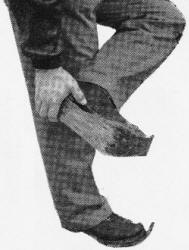
Designer Wears Steel-Shod Shoes so he can use
feet for balance and braking when landing. In free flight, kite will descend slower
than a parachute, but it takes practice to master the single control.
"Flying this machine," says Bensen, a licensed pilot, "is the nearest thing to
flying like a bird that I've ever experienced. There's no structure around you.
There's no noise."
With a 300-foot cable or strong rope, the Gyro-glider can be soared to an altitude
of 150 feet, about the height of a 12-story building. But that's tops. Beyond that,
the upward pull of the rotor and the downward pull of the tow tend to "buffet" or
vibrate the machine and make control difficult.
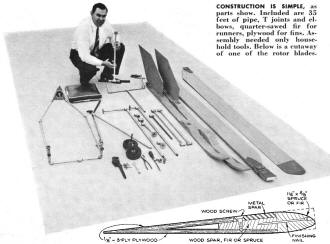
Construction Is Simple, as parts show. Included
are 35 feet of pipe, T joints and elbows, quarter-sawed fir for runners, plywood
for fins. Assembly needed only household tools. Below is a cutaway of one of the
rotor blades.
On Bensen's testimony, the Gyro-glider is not hard to fly. Fore-and-aft, he says,
it's quite stable. Sidewise, it's something else. It takes practice to overcome
the inherent skittishness of the machine laterally. There is only one control for
flying. On the prototype gyro this is a yoke, a loop of steel tubing. Whether a
federal license will be needed to fly the thing has not been decided.
The lifting surfaces are two long, flexible blades, shaped like those of a helicopter
and mounted on a single bearing that lets them teeter-totter in rotating. The teeter-tottering,
plus manipulation of the control yoke, balance out the lift of the blade advancing
into. the wind and the lift of the blade retreating from the wind. Without such
compensation, the machine would tend to capsize - the advancing blade creates more
lift.
The rotating blades form a disk, slightly dished, with their tips a bit higher
than their roots. Centrifugal force wants to hold them straight. The pendulum-like
weight of the "fuselage" and pilot wants to dish them. The result is a compromise.
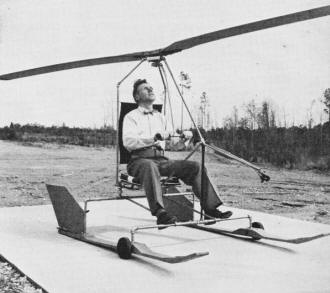
Water-Pipe Version of helicopter kite has standard
six-inch ball-bearing wheels in front, roller-skate wheels in rear. Bensen is revising
undercarriage to make it a three-wheeler. Small fins give directional stability.
Seat cushion was bought at Sears, Roebuck. Machine's height is 64 inches, width
50, length 80. Weight is 86 lb., rotor diameter 20 feet.
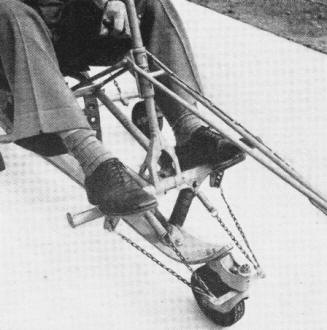
Swiveling Wheel on front of welded prototype
kite allows steering on ground. Pilot's left hand holds handle to release towing
cable. Keel was made from an old ski.
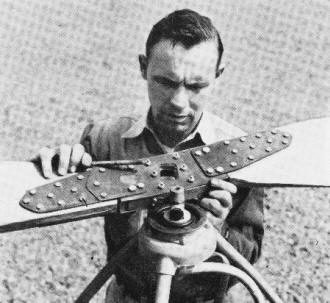
Aluminum Hub Plate secures rotor to shaft. Bearing
is floated on a rubber mount to permit tilting for control. Steel-plate portions
of assembly were cut from machine-shop scraps.
The plane of the disk's rotation can be changed, and that, in fact, is all there
is to the control. Push the yoke forward, and the disk tips backward like a straw
hat clapped on the back of the head. That makes the gyro climb. Pull the yoke back,
and the disk tips forward. That makes it coast downward.
Gyro Lands Like a Plane
Pushing the yoke sideways upsets the balanced lift of the blades as they sweep
through the two side quadrants of the circle they describe around the hub. That
causes the machine to move sideways.
To land, the machine is coasted to the ground and, in a light wind, "flared out"
like an airplane with the disk tilted back. In a strong wind, the machine is "flown
onto" the ground, disk about level, again like an airplane.
Like all blades on rotary-wing aircraft - and like the fixed wings of airplanes,
for that matter - that of the gyro is a true airfoil, with a bulbous leading edge,
a hump on top and a taper to a knife-edge at the back. The blades lift as they rotate
because of Bernoulli's theorem - the air has to speed up to get over the hump. That
thins it, and the air beneath the blade pushes up to fill the semi-vacuum. This
upward push is lift.
Wind rotates the blades, as a gust of air will rotate an idle electric fan. The
blades can't stop in flight. If the horizontal velocity of the wind doesn't keep
them going, its vertical velocity, caused by descent, will.
The real beauty of the Gyro-glider, according to Bensen, is that it takes no
precision to build it. The skimpy structure beneath the rotor of his prototype is
made of welded steel tubing. But that on his second machine, put together to see
how inexpensively it could be built, is largely galvanized water pipe. His rotor
blades are plywood and solid fir, reinforced with a strip of steel an eighth of
an inch thick and two inches wide.
To prove that the blades can be built in a home workshop, Bensen made a pair
of them with leading edges of ordinary half-round bought at the nearest lumber-yard.
It worked pretty well, but he isn't recommending it. More care devoted to blade
shape pays off in increased lift.
"Eye" for V-Boat Wolf Pack
Bensen's acquaintance with aircraft-on-a-string began in World War II when the
V. S. Navy liberated some of them from the Germans. U-boat commanders were using
them as crew's nests. Paid out on a cable, the rotary-wing kites reported by telephone
on the pickings in Allied shipping. This was relayed to the submarine wolf packs.
The kites were reeled in, dismantled and stowed below, and the U-boats were ready
for business.
"Of course," recounts Bensen, Russian-born but U. S.-educated, "the things were
typically German - they had aircraft-type controls, flapping hinges on the rotor,
and other complications."
Working at the time for General Electric, Bensen built and flew his first gyro
in 1945. It did everything the German version would do, and it was simpler. Bensen
went on to mare important research jobs for GE and, later, for a Connecticut helicopter
company. But he kept the design of the aircraft-on-a-string in the back of his head.
He had a reason. In Hartford he had helped form a model-aircraft club for boys.
All the youngsters wanted to fly, but airplanes and gliders were prohibitively expensive.
When, finally, he established his own helicopter company in North Carolina, he began
designing a tethered rotary-wing machine as a gift to the boys' club.
The gyro is a sideline to Bensen's main business - which is the development of
a single-place, military-type helicopter with a novel means of propulsion.
Yet he takes an open delight in flying the machine and likes to tell about how
it cost him money. Before the first flight, his mechanics laid bets on the sly that
the thing would never fly. As fast as the money was offered, the engineers covered
it. Bensen didn't hear about it until after he had gone up and come down again.
He wishes now that he had known. He had a sure thing.
In Popular Science next month: How to build a flying model of the helicopter
kite.
Posted March 30, 2024
|